Strategies for Improving Health Outcomes: Clinical Governance Essay
VerifiedAdded on 2022/09/08
|11
|3173
|10
Essay
AI Summary
This essay delves into the concept of clinical governance as a systematic approach to enhance the quality of healthcare services, emphasizing its importance in improving patient outcomes. It examines the key elements of clinical governance, including education, training, transparency, information management, risk management, clinical audit, and research and development. The essay explores various strategies to improve health outcomes, such as promoting well-informed diagnoses, supporting ideal treatment planning, and taking care of practitioners. It highlights the significance of transparency, risk management, and ethical considerations in healthcare practices. Furthermore, the essay discusses the importance of reporting systems, professional standards, and codes of practice in maintaining and advancing the quality of patient care. It concludes by emphasizing the need for healthcare professionals to adhere to ethical principles and implement effective strategies to ensure the well-being of patients and the overall improvement of healthcare services.
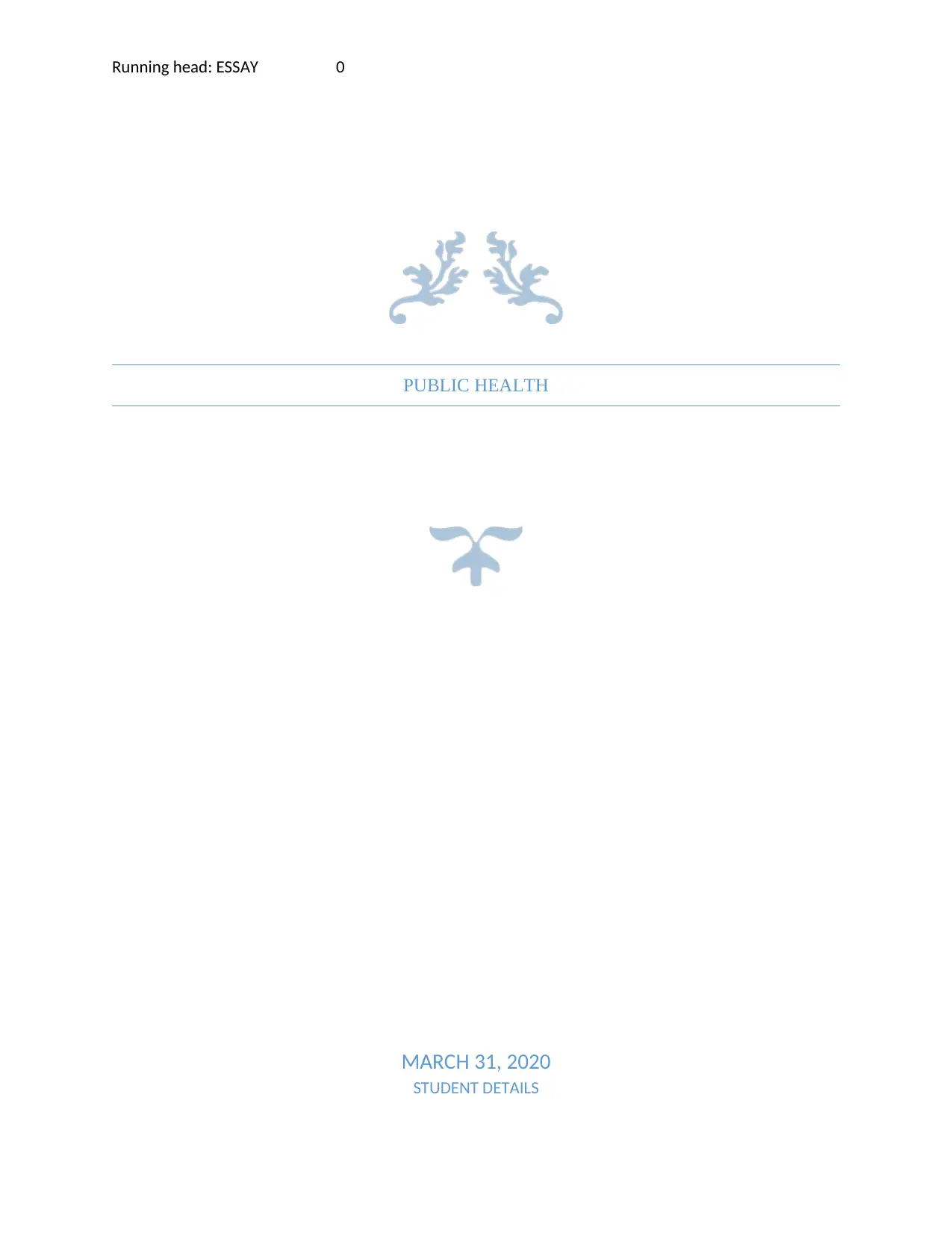
Running head: ESSAY 0
PUBLIC HEALTH
MARCH 31, 2020
STUDENT DETAILS
PUBLIC HEALTH
MARCH 31, 2020
STUDENT DETAILS
Paraphrase This Document
Need a fresh take? Get an instant paraphrase of this document with our AI Paraphraser
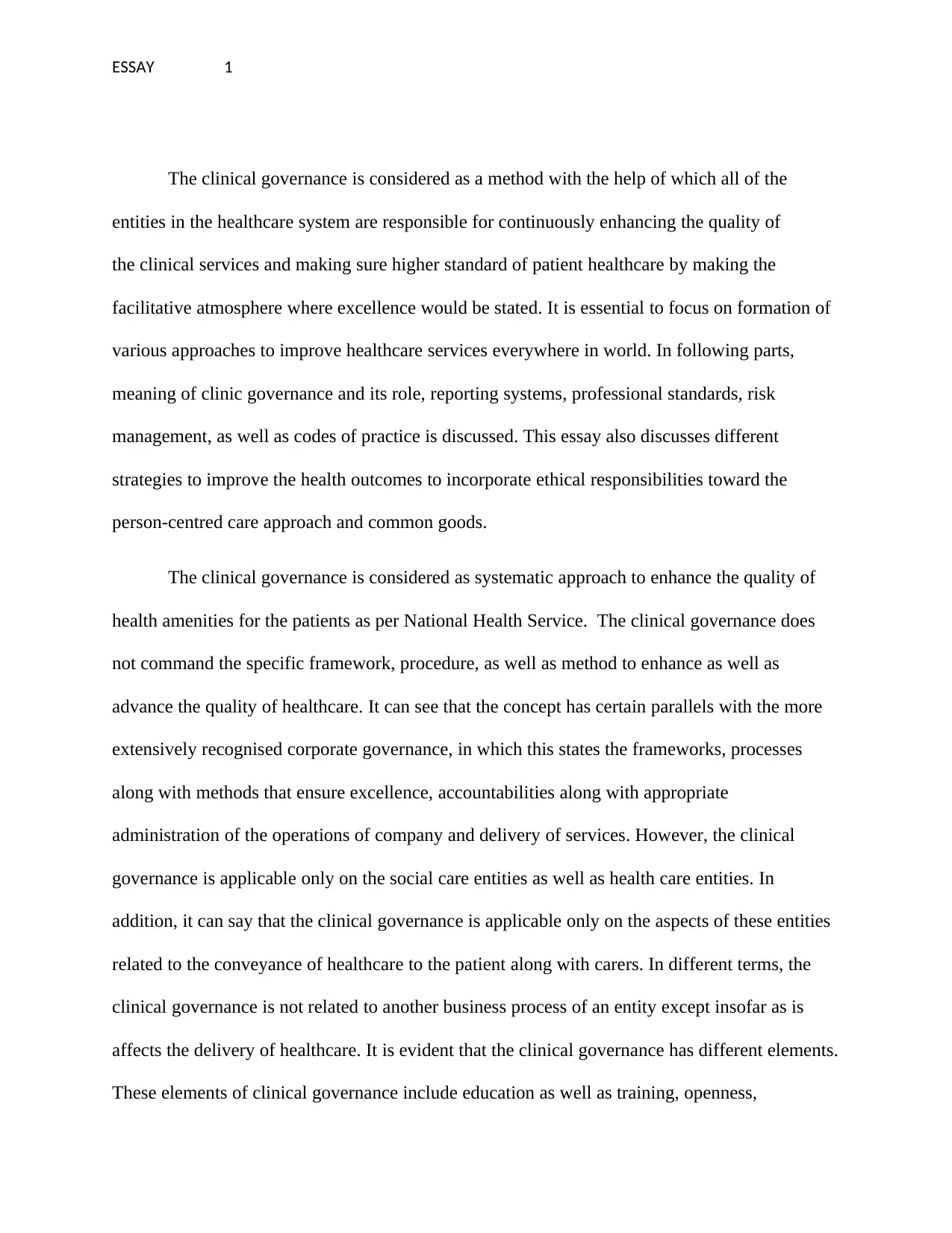
ESSAY 1
The clinical governance is considered as a method with the help of which all of the
entities in the healthcare system are responsible for continuously enhancing the quality of
the clinical services and making sure higher standard of patient healthcare by making the
facilitative atmosphere where excellence would be stated. It is essential to focus on formation of
various approaches to improve healthcare services everywhere in world. In following parts,
meaning of clinic governance and its role, reporting systems, professional standards, risk
management, as well as codes of practice is discussed. This essay also discusses different
strategies to improve the health outcomes to incorporate ethical responsibilities toward the
person-centred care approach and common goods.
The clinical governance is considered as systematic approach to enhance the quality of
health amenities for the patients as per National Health Service. The clinical governance does
not command the specific framework, procedure, as well as method to enhance as well as
advance the quality of healthcare. It can see that the concept has certain parallels with the more
extensively recognised corporate governance, in which this states the frameworks, processes
along with methods that ensure excellence, accountabilities along with appropriate
administration of the operations of company and delivery of services. However, the clinical
governance is applicable only on the social care entities as well as health care entities. In
addition, it can say that the clinical governance is applicable only on the aspects of these entities
related to the conveyance of healthcare to the patient along with carers. In different terms, the
clinical governance is not related to another business process of an entity except insofar as is
affects the delivery of healthcare. It is evident that the clinical governance has different elements.
These elements of clinical governance include education as well as training, openness,
The clinical governance is considered as a method with the help of which all of the
entities in the healthcare system are responsible for continuously enhancing the quality of
the clinical services and making sure higher standard of patient healthcare by making the
facilitative atmosphere where excellence would be stated. It is essential to focus on formation of
various approaches to improve healthcare services everywhere in world. In following parts,
meaning of clinic governance and its role, reporting systems, professional standards, risk
management, as well as codes of practice is discussed. This essay also discusses different
strategies to improve the health outcomes to incorporate ethical responsibilities toward the
person-centred care approach and common goods.
The clinical governance is considered as systematic approach to enhance the quality of
health amenities for the patients as per National Health Service. The clinical governance does
not command the specific framework, procedure, as well as method to enhance as well as
advance the quality of healthcare. It can see that the concept has certain parallels with the more
extensively recognised corporate governance, in which this states the frameworks, processes
along with methods that ensure excellence, accountabilities along with appropriate
administration of the operations of company and delivery of services. However, the clinical
governance is applicable only on the social care entities as well as health care entities. In
addition, it can say that the clinical governance is applicable only on the aspects of these entities
related to the conveyance of healthcare to the patient along with carers. In different terms, the
clinical governance is not related to another business process of an entity except insofar as is
affects the delivery of healthcare. It is evident that the clinical governance has different elements.
These elements of clinical governance include education as well as training, openness,
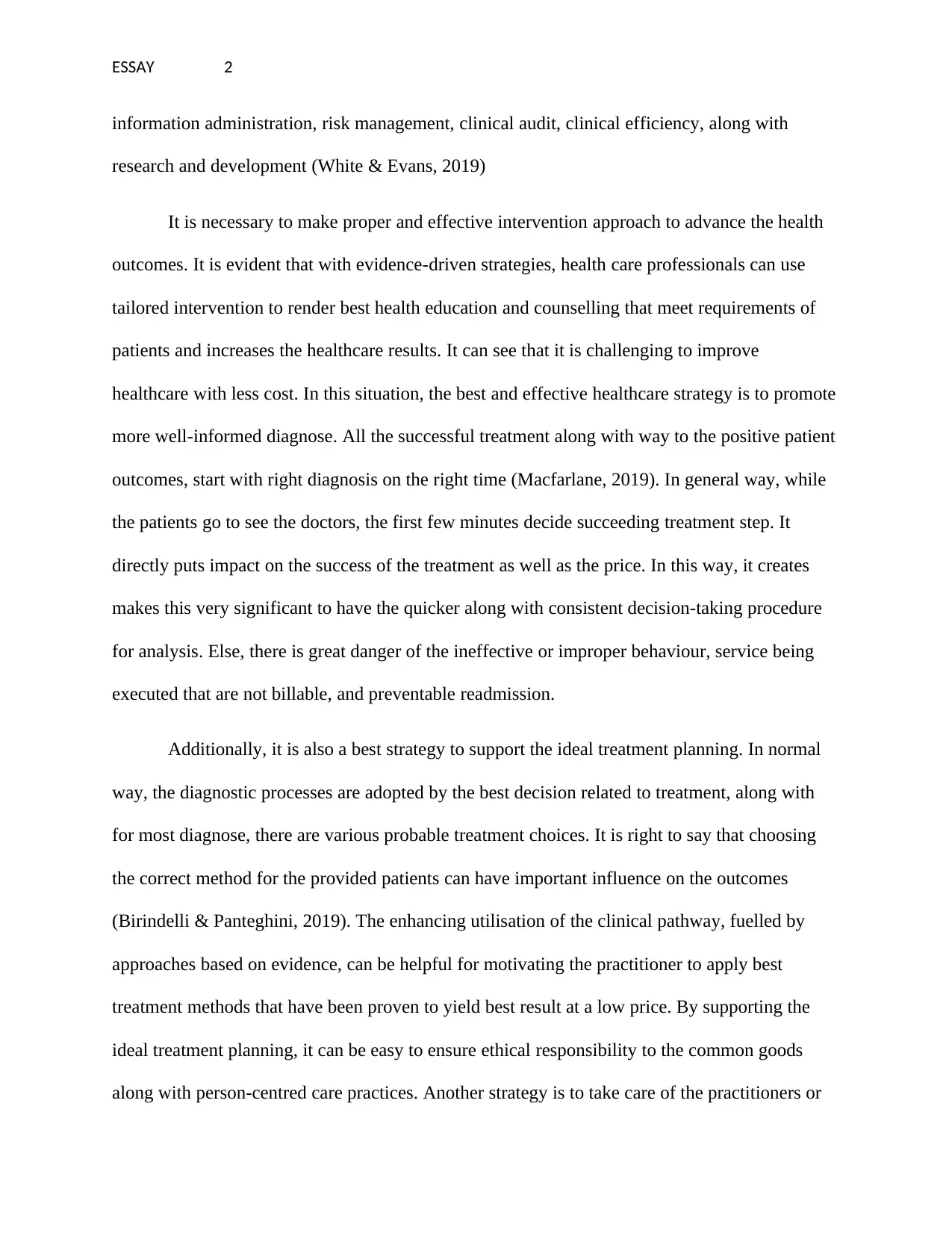
ESSAY 2
information administration, risk management, clinical audit, clinical efficiency, along with
research and development (White & Evans, 2019)
It is necessary to make proper and effective intervention approach to advance the health
outcomes. It is evident that with evidence-driven strategies, health care professionals can use
tailored intervention to render best health education and counselling that meet requirements of
patients and increases the healthcare results. It can see that it is challenging to improve
healthcare with less cost. In this situation, the best and effective healthcare strategy is to promote
more well-informed diagnose. All the successful treatment along with way to the positive patient
outcomes, start with right diagnosis on the right time (Macfarlane, 2019). In general way, while
the patients go to see the doctors, the first few minutes decide succeeding treatment step. It
directly puts impact on the success of the treatment as well as the price. In this way, it creates
makes this very significant to have the quicker along with consistent decision-taking procedure
for analysis. Else, there is great danger of the ineffective or improper behaviour, service being
executed that are not billable, and preventable readmission.
Additionally, it is also a best strategy to support the ideal treatment planning. In normal
way, the diagnostic processes are adopted by the best decision related to treatment, along with
for most diagnose, there are various probable treatment choices. It is right to say that choosing
the correct method for the provided patients can have important influence on the outcomes
(Birindelli & Panteghini, 2019). The enhancing utilisation of the clinical pathway, fuelled by
approaches based on evidence, can be helpful for motivating the practitioner to apply best
treatment methods that have been proven to yield best result at a low price. By supporting the
ideal treatment planning, it can be easy to ensure ethical responsibility to the common goods
along with person-centred care practices. Another strategy is to take care of the practitioners or
information administration, risk management, clinical audit, clinical efficiency, along with
research and development (White & Evans, 2019)
It is necessary to make proper and effective intervention approach to advance the health
outcomes. It is evident that with evidence-driven strategies, health care professionals can use
tailored intervention to render best health education and counselling that meet requirements of
patients and increases the healthcare results. It can see that it is challenging to improve
healthcare with less cost. In this situation, the best and effective healthcare strategy is to promote
more well-informed diagnose. All the successful treatment along with way to the positive patient
outcomes, start with right diagnosis on the right time (Macfarlane, 2019). In general way, while
the patients go to see the doctors, the first few minutes decide succeeding treatment step. It
directly puts impact on the success of the treatment as well as the price. In this way, it creates
makes this very significant to have the quicker along with consistent decision-taking procedure
for analysis. Else, there is great danger of the ineffective or improper behaviour, service being
executed that are not billable, and preventable readmission.
Additionally, it is also a best strategy to support the ideal treatment planning. In normal
way, the diagnostic processes are adopted by the best decision related to treatment, along with
for most diagnose, there are various probable treatment choices. It is right to say that choosing
the correct method for the provided patients can have important influence on the outcomes
(Birindelli & Panteghini, 2019). The enhancing utilisation of the clinical pathway, fuelled by
approaches based on evidence, can be helpful for motivating the practitioner to apply best
treatment methods that have been proven to yield best result at a low price. By supporting the
ideal treatment planning, it can be easy to ensure ethical responsibility to the common goods
along with person-centred care practices. Another strategy is to take care of the practitioners or
⊘ This is a preview!⊘
Do you want full access?
Subscribe today to unlock all pages.

Trusted by 1+ million students worldwide
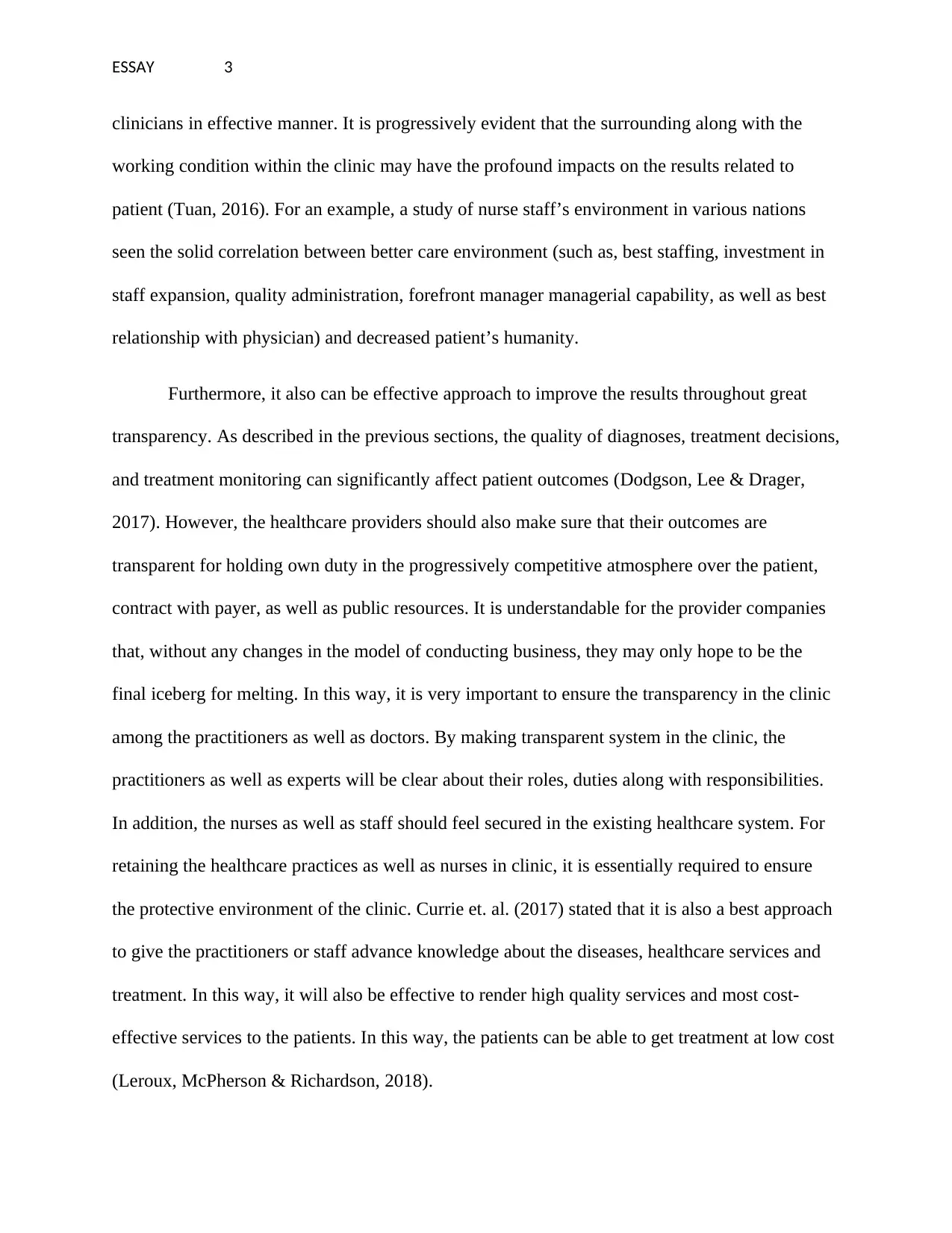
ESSAY 3
clinicians in effective manner. It is progressively evident that the surrounding along with the
working condition within the clinic may have the profound impacts on the results related to
patient (Tuan, 2016). For an example, a study of nurse staff’s environment in various nations
seen the solid correlation between better care environment (such as, best staffing, investment in
staff expansion, quality administration, forefront manager managerial capability, as well as best
relationship with physician) and decreased patient’s humanity.
Furthermore, it also can be effective approach to improve the results throughout great
transparency. As described in the previous sections, the quality of diagnoses, treatment decisions,
and treatment monitoring can significantly affect patient outcomes (Dodgson, Lee & Drager,
2017). However, the healthcare providers should also make sure that their outcomes are
transparent for holding own duty in the progressively competitive atmosphere over the patient,
contract with payer, as well as public resources. It is understandable for the provider companies
that, without any changes in the model of conducting business, they may only hope to be the
final iceberg for melting. In this way, it is very important to ensure the transparency in the clinic
among the practitioners as well as doctors. By making transparent system in the clinic, the
practitioners as well as experts will be clear about their roles, duties along with responsibilities.
In addition, the nurses as well as staff should feel secured in the existing healthcare system. For
retaining the healthcare practices as well as nurses in clinic, it is essentially required to ensure
the protective environment of the clinic. Currie et. al. (2017) stated that it is also a best approach
to give the practitioners or staff advance knowledge about the diseases, healthcare services and
treatment. In this way, it will also be effective to render high quality services and most cost-
effective services to the patients. In this way, the patients can be able to get treatment at low cost
(Leroux, McPherson & Richardson, 2018).
clinicians in effective manner. It is progressively evident that the surrounding along with the
working condition within the clinic may have the profound impacts on the results related to
patient (Tuan, 2016). For an example, a study of nurse staff’s environment in various nations
seen the solid correlation between better care environment (such as, best staffing, investment in
staff expansion, quality administration, forefront manager managerial capability, as well as best
relationship with physician) and decreased patient’s humanity.
Furthermore, it also can be effective approach to improve the results throughout great
transparency. As described in the previous sections, the quality of diagnoses, treatment decisions,
and treatment monitoring can significantly affect patient outcomes (Dodgson, Lee & Drager,
2017). However, the healthcare providers should also make sure that their outcomes are
transparent for holding own duty in the progressively competitive atmosphere over the patient,
contract with payer, as well as public resources. It is understandable for the provider companies
that, without any changes in the model of conducting business, they may only hope to be the
final iceberg for melting. In this way, it is very important to ensure the transparency in the clinic
among the practitioners as well as doctors. By making transparent system in the clinic, the
practitioners as well as experts will be clear about their roles, duties along with responsibilities.
In addition, the nurses as well as staff should feel secured in the existing healthcare system. For
retaining the healthcare practices as well as nurses in clinic, it is essentially required to ensure
the protective environment of the clinic. Currie et. al. (2017) stated that it is also a best approach
to give the practitioners or staff advance knowledge about the diseases, healthcare services and
treatment. In this way, it will also be effective to render high quality services and most cost-
effective services to the patients. In this way, the patients can be able to get treatment at low cost
(Leroux, McPherson & Richardson, 2018).
Paraphrase This Document
Need a fresh take? Get an instant paraphrase of this document with our AI Paraphraser
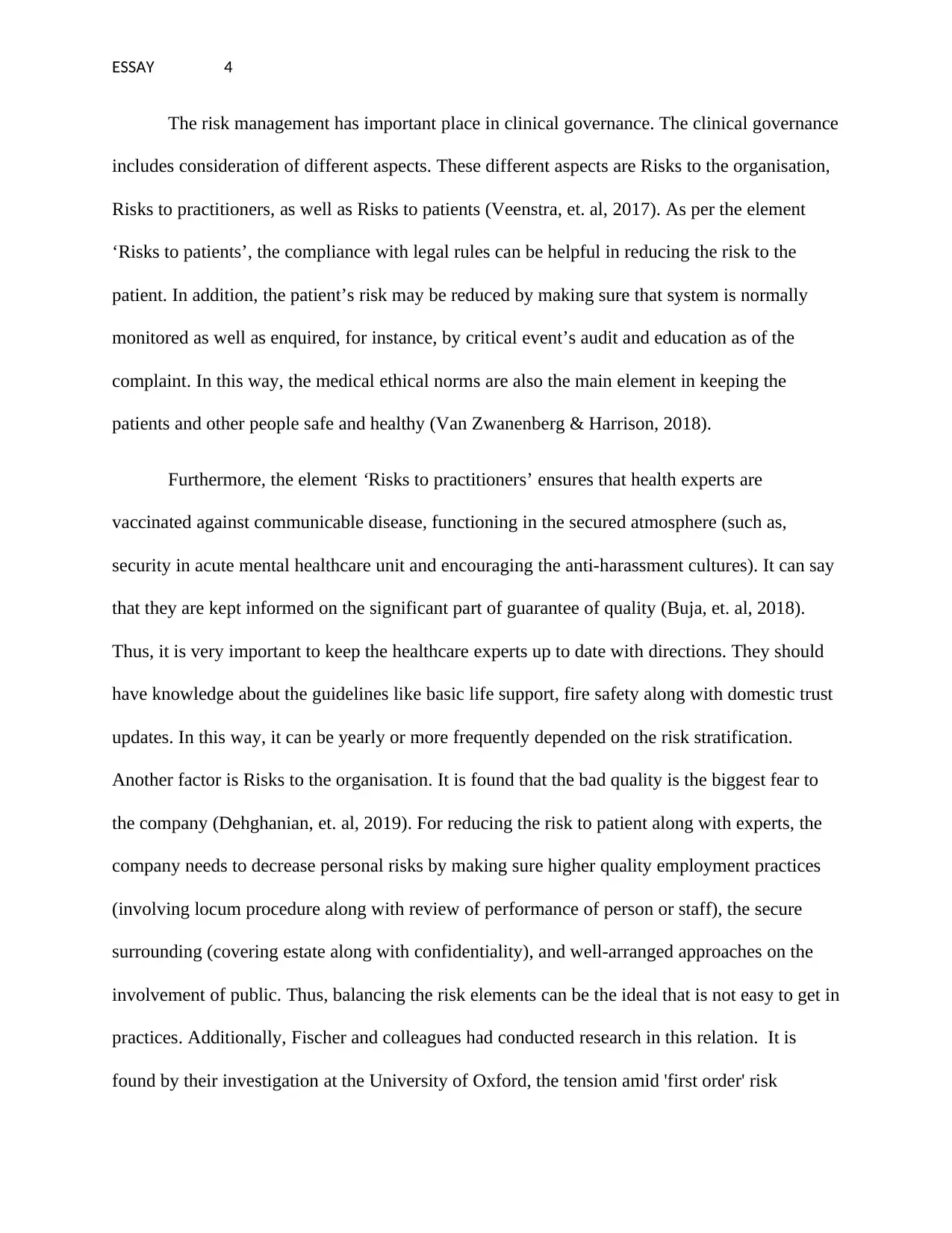
ESSAY 4
The risk management has important place in clinical governance. The clinical governance
includes consideration of different aspects. These different aspects are Risks to the organisation,
Risks to practitioners, as well as Risks to patients (Veenstra, et. al, 2017). As per the element
‘Risks to patients’, the compliance with legal rules can be helpful in reducing the risk to the
patient. In addition, the patient’s risk may be reduced by making sure that system is normally
monitored as well as enquired, for instance, by critical event’s audit and education as of the
complaint. In this way, the medical ethical norms are also the main element in keeping the
patients and other people safe and healthy (Van Zwanenberg & Harrison, 2018).
Furthermore, the element ‘Risks to practitioners’ ensures that health experts are
vaccinated against communicable disease, functioning in the secured atmosphere (such as,
security in acute mental healthcare unit and encouraging the anti-harassment cultures). It can say
that they are kept informed on the significant part of guarantee of quality (Buja, et. al, 2018).
Thus, it is very important to keep the healthcare experts up to date with directions. They should
have knowledge about the guidelines like basic life support, fire safety along with domestic trust
updates. In this way, it can be yearly or more frequently depended on the risk stratification.
Another factor is Risks to the organisation. It is found that the bad quality is the biggest fear to
the company (Dehghanian, et. al, 2019). For reducing the risk to patient along with experts, the
company needs to decrease personal risks by making sure higher quality employment practices
(involving locum procedure along with review of performance of person or staff), the secure
surrounding (covering estate along with confidentiality), and well-arranged approaches on the
involvement of public. Thus, balancing the risk elements can be the ideal that is not easy to get in
practices. Additionally, Fischer and colleagues had conducted research in this relation. It is
found by their investigation at the University of Oxford, the tension amid 'first order' risk
The risk management has important place in clinical governance. The clinical governance
includes consideration of different aspects. These different aspects are Risks to the organisation,
Risks to practitioners, as well as Risks to patients (Veenstra, et. al, 2017). As per the element
‘Risks to patients’, the compliance with legal rules can be helpful in reducing the risk to the
patient. In addition, the patient’s risk may be reduced by making sure that system is normally
monitored as well as enquired, for instance, by critical event’s audit and education as of the
complaint. In this way, the medical ethical norms are also the main element in keeping the
patients and other people safe and healthy (Van Zwanenberg & Harrison, 2018).
Furthermore, the element ‘Risks to practitioners’ ensures that health experts are
vaccinated against communicable disease, functioning in the secured atmosphere (such as,
security in acute mental healthcare unit and encouraging the anti-harassment cultures). It can say
that they are kept informed on the significant part of guarantee of quality (Buja, et. al, 2018).
Thus, it is very important to keep the healthcare experts up to date with directions. They should
have knowledge about the guidelines like basic life support, fire safety along with domestic trust
updates. In this way, it can be yearly or more frequently depended on the risk stratification.
Another factor is Risks to the organisation. It is found that the bad quality is the biggest fear to
the company (Dehghanian, et. al, 2019). For reducing the risk to patient along with experts, the
company needs to decrease personal risks by making sure higher quality employment practices
(involving locum procedure along with review of performance of person or staff), the secure
surrounding (covering estate along with confidentiality), and well-arranged approaches on the
involvement of public. Thus, balancing the risk elements can be the ideal that is not easy to get in
practices. Additionally, Fischer and colleagues had conducted research in this relation. It is
found by their investigation at the University of Oxford, the tension amid 'first order' risk
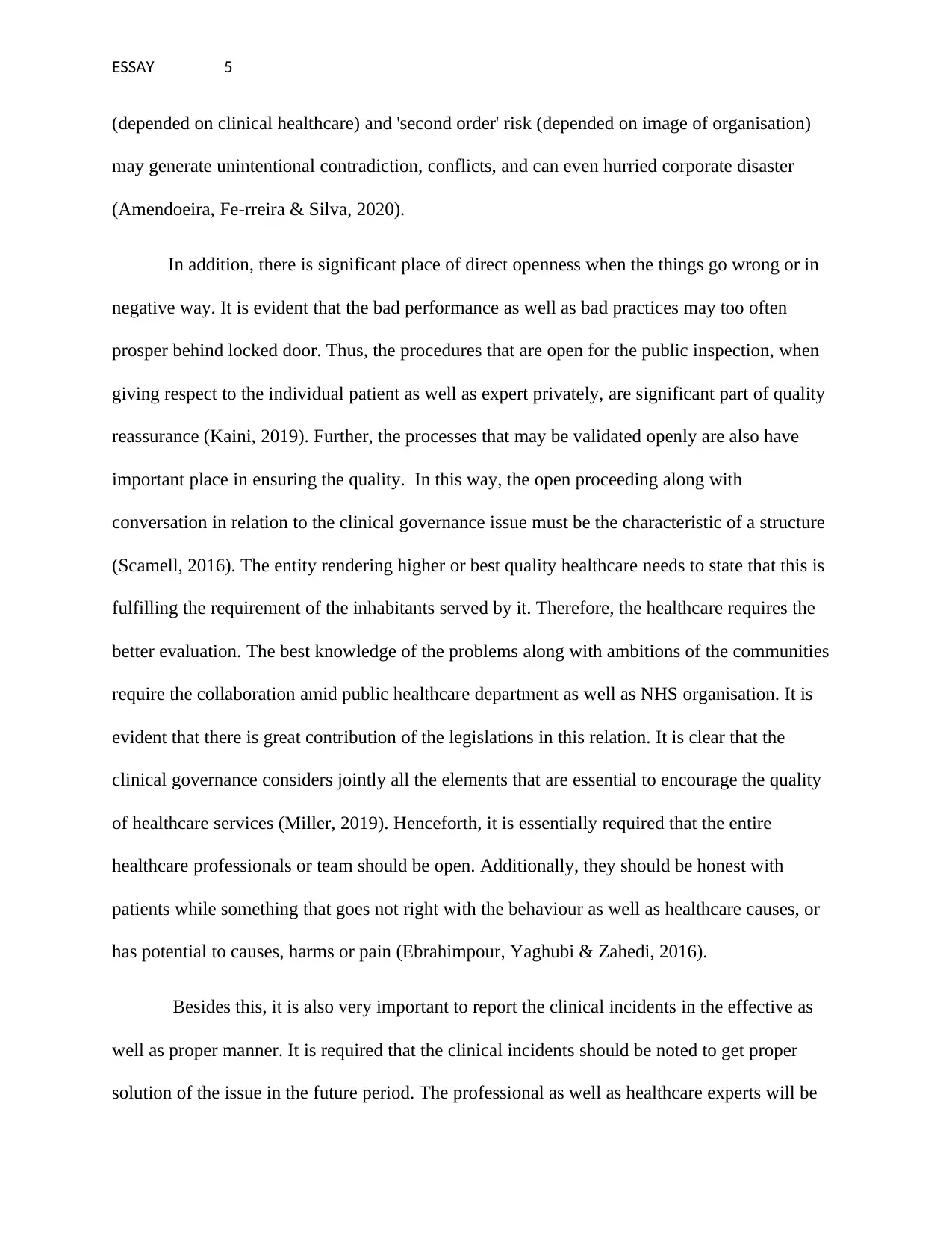
ESSAY 5
(depended on clinical healthcare) and 'second order' risk (depended on image of organisation)
may generate unintentional contradiction, conflicts, and can even hurried corporate disaster
(Amendoeira, Fe-rreira & Silva, 2020).
In addition, there is significant place of direct openness when the things go wrong or in
negative way. It is evident that the bad performance as well as bad practices may too often
prosper behind locked door. Thus, the procedures that are open for the public inspection, when
giving respect to the individual patient as well as expert privately, are significant part of quality
reassurance (Kaini, 2019). Further, the processes that may be validated openly are also have
important place in ensuring the quality. In this way, the open proceeding along with
conversation in relation to the clinical governance issue must be the characteristic of a structure
(Scamell, 2016). The entity rendering higher or best quality healthcare needs to state that this is
fulfilling the requirement of the inhabitants served by it. Therefore, the healthcare requires the
better evaluation. The best knowledge of the problems along with ambitions of the communities
require the collaboration amid public healthcare department as well as NHS organisation. It is
evident that there is great contribution of the legislations in this relation. It is clear that the
clinical governance considers jointly all the elements that are essential to encourage the quality
of healthcare services (Miller, 2019). Henceforth, it is essentially required that the entire
healthcare professionals or team should be open. Additionally, they should be honest with
patients while something that goes not right with the behaviour as well as healthcare causes, or
has potential to causes, harms or pain (Ebrahimpour, Yaghubi & Zahedi, 2016).
Besides this, it is also very important to report the clinical incidents in the effective as
well as proper manner. It is required that the clinical incidents should be noted to get proper
solution of the issue in the future period. The professional as well as healthcare experts will be
(depended on clinical healthcare) and 'second order' risk (depended on image of organisation)
may generate unintentional contradiction, conflicts, and can even hurried corporate disaster
(Amendoeira, Fe-rreira & Silva, 2020).
In addition, there is significant place of direct openness when the things go wrong or in
negative way. It is evident that the bad performance as well as bad practices may too often
prosper behind locked door. Thus, the procedures that are open for the public inspection, when
giving respect to the individual patient as well as expert privately, are significant part of quality
reassurance (Kaini, 2019). Further, the processes that may be validated openly are also have
important place in ensuring the quality. In this way, the open proceeding along with
conversation in relation to the clinical governance issue must be the characteristic of a structure
(Scamell, 2016). The entity rendering higher or best quality healthcare needs to state that this is
fulfilling the requirement of the inhabitants served by it. Therefore, the healthcare requires the
better evaluation. The best knowledge of the problems along with ambitions of the communities
require the collaboration amid public healthcare department as well as NHS organisation. It is
evident that there is great contribution of the legislations in this relation. It is clear that the
clinical governance considers jointly all the elements that are essential to encourage the quality
of healthcare services (Miller, 2019). Henceforth, it is essentially required that the entire
healthcare professionals or team should be open. Additionally, they should be honest with
patients while something that goes not right with the behaviour as well as healthcare causes, or
has potential to causes, harms or pain (Ebrahimpour, Yaghubi & Zahedi, 2016).
Besides this, it is also very important to report the clinical incidents in the effective as
well as proper manner. It is required that the clinical incidents should be noted to get proper
solution of the issue in the future period. The professional as well as healthcare experts will be
⊘ This is a preview!⊘
Do you want full access?
Subscribe today to unlock all pages.

Trusted by 1+ million students worldwide
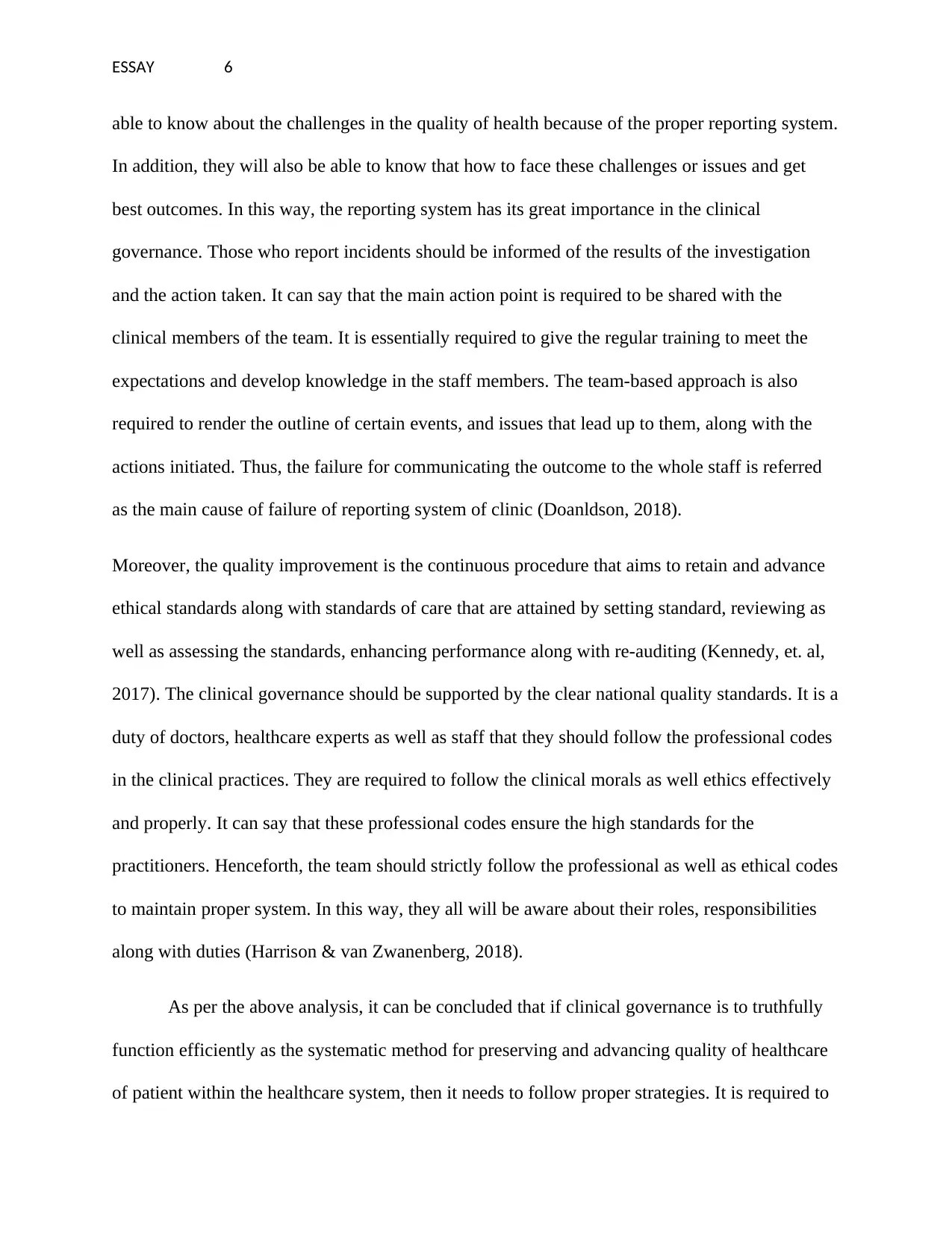
ESSAY 6
able to know about the challenges in the quality of health because of the proper reporting system.
In addition, they will also be able to know that how to face these challenges or issues and get
best outcomes. In this way, the reporting system has its great importance in the clinical
governance. Those who report incidents should be informed of the results of the investigation
and the action taken. It can say that the main action point is required to be shared with the
clinical members of the team. It is essentially required to give the regular training to meet the
expectations and develop knowledge in the staff members. The team-based approach is also
required to render the outline of certain events, and issues that lead up to them, along with the
actions initiated. Thus, the failure for communicating the outcome to the whole staff is referred
as the main cause of failure of reporting system of clinic (Doanldson, 2018).
Moreover, the quality improvement is the continuous procedure that aims to retain and advance
ethical standards along with standards of care that are attained by setting standard, reviewing as
well as assessing the standards, enhancing performance along with re-auditing (Kennedy, et. al,
2017). The clinical governance should be supported by the clear national quality standards. It is a
duty of doctors, healthcare experts as well as staff that they should follow the professional codes
in the clinical practices. They are required to follow the clinical morals as well ethics effectively
and properly. It can say that these professional codes ensure the high standards for the
practitioners. Henceforth, the team should strictly follow the professional as well as ethical codes
to maintain proper system. In this way, they all will be aware about their roles, responsibilities
along with duties (Harrison & van Zwanenberg, 2018).
As per the above analysis, it can be concluded that if clinical governance is to truthfully
function efficiently as the systematic method for preserving and advancing quality of healthcare
of patient within the healthcare system, then it needs to follow proper strategies. It is required to
able to know about the challenges in the quality of health because of the proper reporting system.
In addition, they will also be able to know that how to face these challenges or issues and get
best outcomes. In this way, the reporting system has its great importance in the clinical
governance. Those who report incidents should be informed of the results of the investigation
and the action taken. It can say that the main action point is required to be shared with the
clinical members of the team. It is essentially required to give the regular training to meet the
expectations and develop knowledge in the staff members. The team-based approach is also
required to render the outline of certain events, and issues that lead up to them, along with the
actions initiated. Thus, the failure for communicating the outcome to the whole staff is referred
as the main cause of failure of reporting system of clinic (Doanldson, 2018).
Moreover, the quality improvement is the continuous procedure that aims to retain and advance
ethical standards along with standards of care that are attained by setting standard, reviewing as
well as assessing the standards, enhancing performance along with re-auditing (Kennedy, et. al,
2017). The clinical governance should be supported by the clear national quality standards. It is a
duty of doctors, healthcare experts as well as staff that they should follow the professional codes
in the clinical practices. They are required to follow the clinical morals as well ethics effectively
and properly. It can say that these professional codes ensure the high standards for the
practitioners. Henceforth, the team should strictly follow the professional as well as ethical codes
to maintain proper system. In this way, they all will be aware about their roles, responsibilities
along with duties (Harrison & van Zwanenberg, 2018).
As per the above analysis, it can be concluded that if clinical governance is to truthfully
function efficiently as the systematic method for preserving and advancing quality of healthcare
of patient within the healthcare system, then it needs to follow proper strategies. It is required to
Paraphrase This Document
Need a fresh take? Get an instant paraphrase of this document with our AI Paraphraser
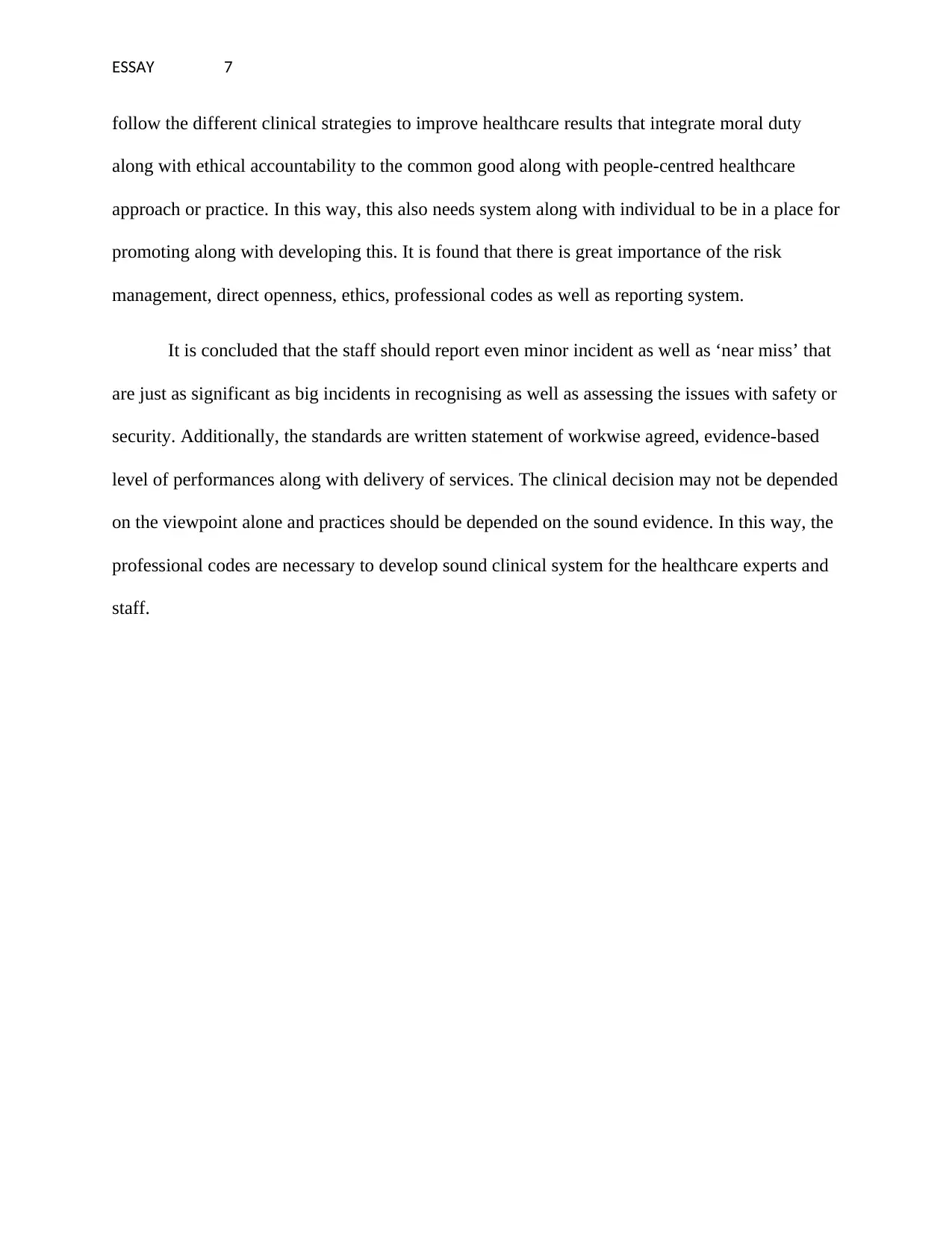
ESSAY 7
follow the different clinical strategies to improve healthcare results that integrate moral duty
along with ethical accountability to the common good along with people-centred healthcare
approach or practice. In this way, this also needs system along with individual to be in a place for
promoting along with developing this. It is found that there is great importance of the risk
management, direct openness, ethics, professional codes as well as reporting system.
It is concluded that the staff should report even minor incident as well as ‘near miss’ that
are just as significant as big incidents in recognising as well as assessing the issues with safety or
security. Additionally, the standards are written statement of workwise agreed, evidence-based
level of performances along with delivery of services. The clinical decision may not be depended
on the viewpoint alone and practices should be depended on the sound evidence. In this way, the
professional codes are necessary to develop sound clinical system for the healthcare experts and
staff.
follow the different clinical strategies to improve healthcare results that integrate moral duty
along with ethical accountability to the common good along with people-centred healthcare
approach or practice. In this way, this also needs system along with individual to be in a place for
promoting along with developing this. It is found that there is great importance of the risk
management, direct openness, ethics, professional codes as well as reporting system.
It is concluded that the staff should report even minor incident as well as ‘near miss’ that
are just as significant as big incidents in recognising as well as assessing the issues with safety or
security. Additionally, the standards are written statement of workwise agreed, evidence-based
level of performances along with delivery of services. The clinical decision may not be depended
on the viewpoint alone and practices should be depended on the sound evidence. In this way, the
professional codes are necessary to develop sound clinical system for the healthcare experts and
staff.
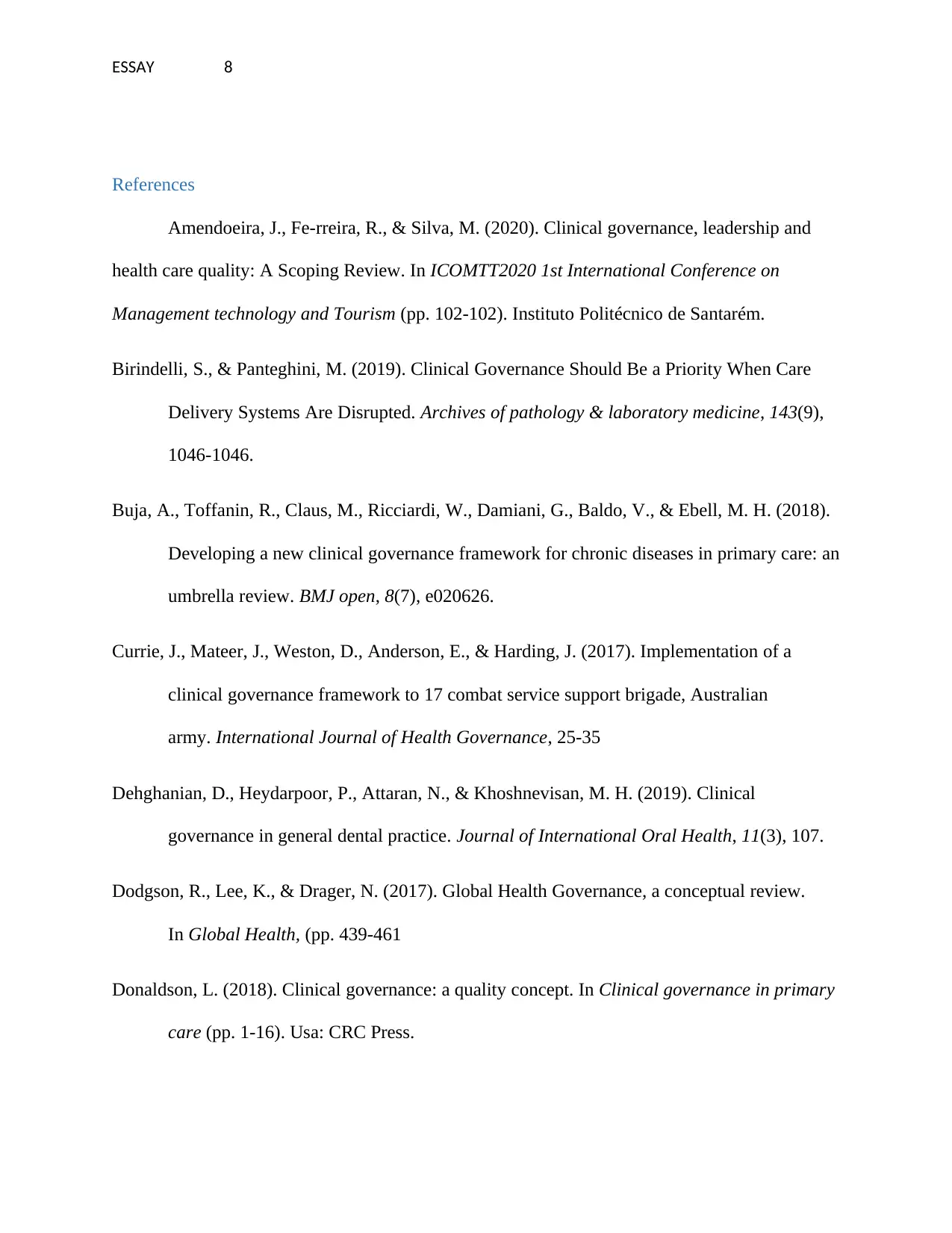
ESSAY 8
References
Amendoeira, J., Fe-rreira, R., & Silva, M. (2020). Clinical governance, leadership and
health care quality: A Scoping Review. In ICOMTT2020 1st International Conference on
Management technology and Tourism (pp. 102-102). Instituto Politécnico de Santarém.
Birindelli, S., & Panteghini, M. (2019). Clinical Governance Should Be a Priority When Care
Delivery Systems Are Disrupted. Archives of pathology & laboratory medicine, 143(9),
1046-1046.
Buja, A., Toffanin, R., Claus, M., Ricciardi, W., Damiani, G., Baldo, V., & Ebell, M. H. (2018).
Developing a new clinical governance framework for chronic diseases in primary care: an
umbrella review. BMJ open, 8(7), e020626.
Currie, J., Mateer, J., Weston, D., Anderson, E., & Harding, J. (2017). Implementation of a
clinical governance framework to 17 combat service support brigade, Australian
army. International Journal of Health Governance, 25-35
Dehghanian, D., Heydarpoor, P., Attaran, N., & Khoshnevisan, M. H. (2019). Clinical
governance in general dental practice. Journal of International Oral Health, 11(3), 107.
Dodgson, R., Lee, K., & Drager, N. (2017). Global Health Governance, a conceptual review.
In Global Health, (pp. 439-461
Donaldson, L. (2018). Clinical governance: a quality concept. In Clinical governance in primary
care (pp. 1-16). Usa: CRC Press.
References
Amendoeira, J., Fe-rreira, R., & Silva, M. (2020). Clinical governance, leadership and
health care quality: A Scoping Review. In ICOMTT2020 1st International Conference on
Management technology and Tourism (pp. 102-102). Instituto Politécnico de Santarém.
Birindelli, S., & Panteghini, M. (2019). Clinical Governance Should Be a Priority When Care
Delivery Systems Are Disrupted. Archives of pathology & laboratory medicine, 143(9),
1046-1046.
Buja, A., Toffanin, R., Claus, M., Ricciardi, W., Damiani, G., Baldo, V., & Ebell, M. H. (2018).
Developing a new clinical governance framework for chronic diseases in primary care: an
umbrella review. BMJ open, 8(7), e020626.
Currie, J., Mateer, J., Weston, D., Anderson, E., & Harding, J. (2017). Implementation of a
clinical governance framework to 17 combat service support brigade, Australian
army. International Journal of Health Governance, 25-35
Dehghanian, D., Heydarpoor, P., Attaran, N., & Khoshnevisan, M. H. (2019). Clinical
governance in general dental practice. Journal of International Oral Health, 11(3), 107.
Dodgson, R., Lee, K., & Drager, N. (2017). Global Health Governance, a conceptual review.
In Global Health, (pp. 439-461
Donaldson, L. (2018). Clinical governance: a quality concept. In Clinical governance in primary
care (pp. 1-16). Usa: CRC Press.
⊘ This is a preview!⊘
Do you want full access?
Subscribe today to unlock all pages.

Trusted by 1+ million students worldwide
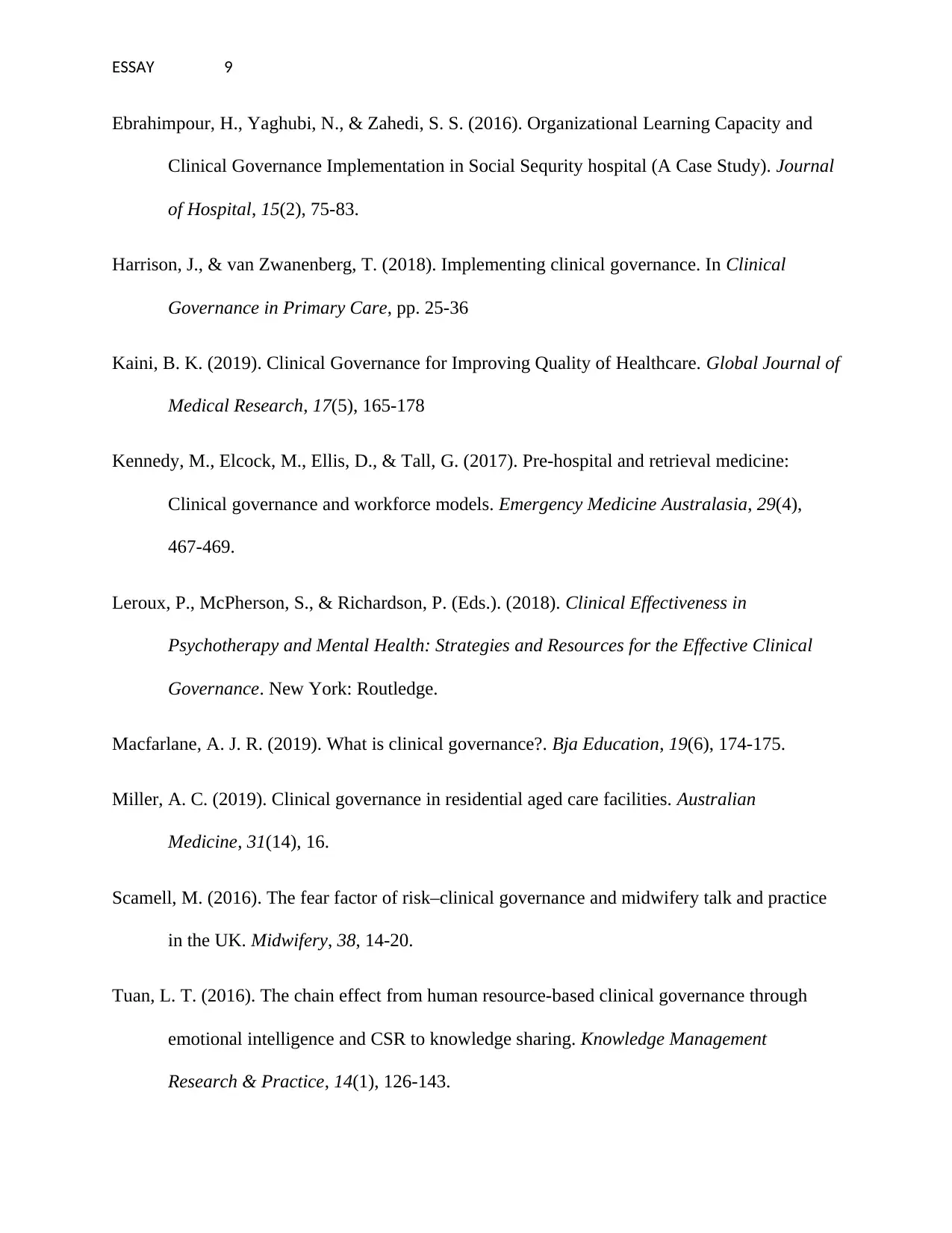
ESSAY 9
Ebrahimpour, H., Yaghubi, N., & Zahedi, S. S. (2016). Organizational Learning Capacity and
Clinical Governance Implementation in Social Sequrity hospital (A Case Study). Journal
of Hospital, 15(2), 75-83.
Harrison, J., & van Zwanenberg, T. (2018). Implementing clinical governance. In Clinical
Governance in Primary Care, pp. 25-36
Kaini, B. K. (2019). Clinical Governance for Improving Quality of Healthcare. Global Journal of
Medical Research, 17(5), 165-178
Kennedy, M., Elcock, M., Ellis, D., & Tall, G. (2017). Pre‐hospital and retrieval medicine:
Clinical governance and workforce models. Emergency Medicine Australasia, 29(4),
467-469.
Leroux, P., McPherson, S., & Richardson, P. (Eds.). (2018). Clinical Effectiveness in
Psychotherapy and Mental Health: Strategies and Resources for the Effective Clinical
Governance. New York: Routledge.
Macfarlane, A. J. R. (2019). What is clinical governance?. Bja Education, 19(6), 174-175.
Miller, A. C. (2019). Clinical governance in residential aged care facilities. Australian
Medicine, 31(14), 16.
Scamell, M. (2016). The fear factor of risk–clinical governance and midwifery talk and practice
in the UK. Midwifery, 38, 14-20.
Tuan, L. T. (2016). The chain effect from human resource-based clinical governance through
emotional intelligence and CSR to knowledge sharing. Knowledge Management
Research & Practice, 14(1), 126-143.
Ebrahimpour, H., Yaghubi, N., & Zahedi, S. S. (2016). Organizational Learning Capacity and
Clinical Governance Implementation in Social Sequrity hospital (A Case Study). Journal
of Hospital, 15(2), 75-83.
Harrison, J., & van Zwanenberg, T. (2018). Implementing clinical governance. In Clinical
Governance in Primary Care, pp. 25-36
Kaini, B. K. (2019). Clinical Governance for Improving Quality of Healthcare. Global Journal of
Medical Research, 17(5), 165-178
Kennedy, M., Elcock, M., Ellis, D., & Tall, G. (2017). Pre‐hospital and retrieval medicine:
Clinical governance and workforce models. Emergency Medicine Australasia, 29(4),
467-469.
Leroux, P., McPherson, S., & Richardson, P. (Eds.). (2018). Clinical Effectiveness in
Psychotherapy and Mental Health: Strategies and Resources for the Effective Clinical
Governance. New York: Routledge.
Macfarlane, A. J. R. (2019). What is clinical governance?. Bja Education, 19(6), 174-175.
Miller, A. C. (2019). Clinical governance in residential aged care facilities. Australian
Medicine, 31(14), 16.
Scamell, M. (2016). The fear factor of risk–clinical governance and midwifery talk and practice
in the UK. Midwifery, 38, 14-20.
Tuan, L. T. (2016). The chain effect from human resource-based clinical governance through
emotional intelligence and CSR to knowledge sharing. Knowledge Management
Research & Practice, 14(1), 126-143.
Paraphrase This Document
Need a fresh take? Get an instant paraphrase of this document with our AI Paraphraser
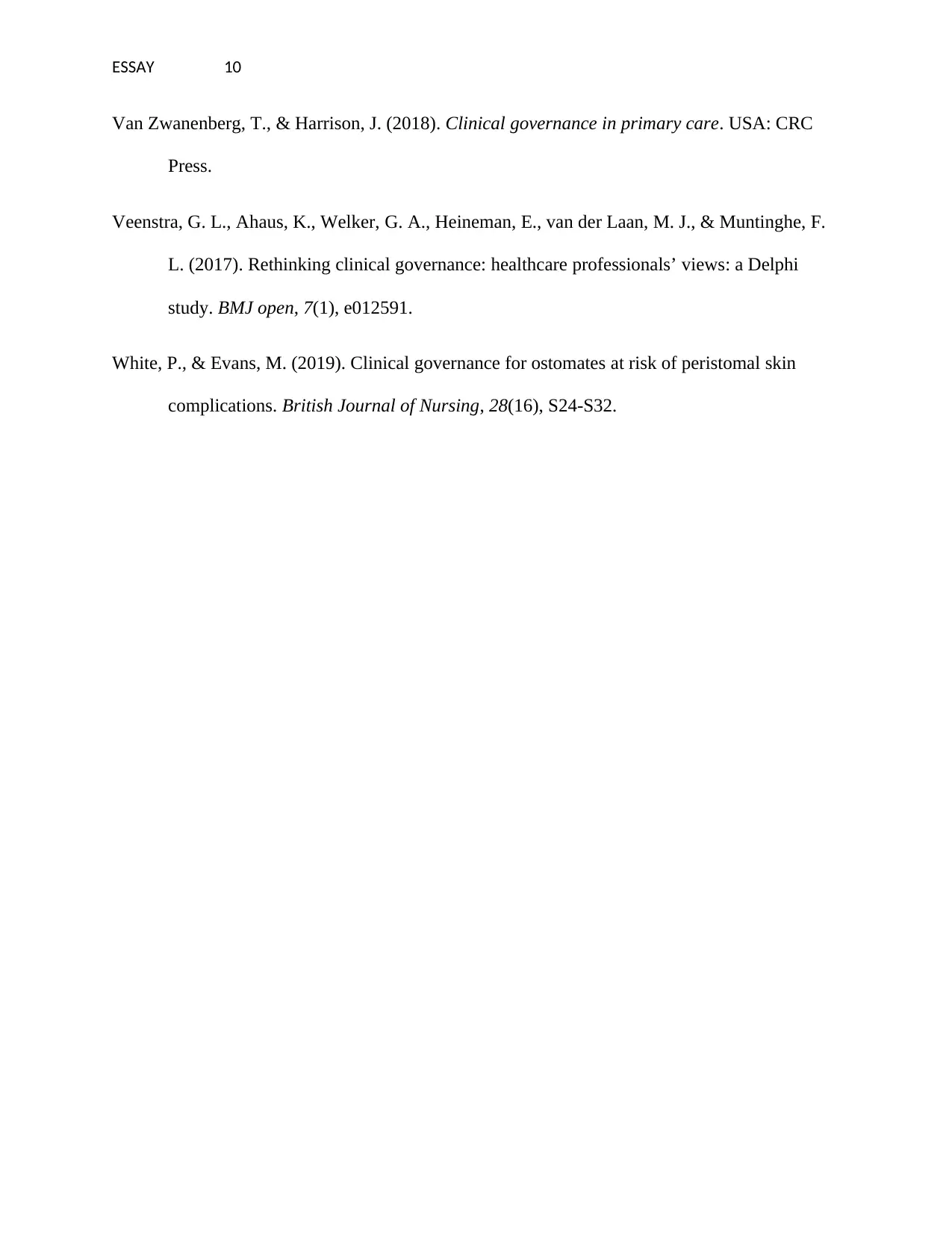
ESSAY 10
Van Zwanenberg, T., & Harrison, J. (2018). Clinical governance in primary care. USA: CRC
Press.
Veenstra, G. L., Ahaus, K., Welker, G. A., Heineman, E., van der Laan, M. J., & Muntinghe, F.
L. (2017). Rethinking clinical governance: healthcare professionals’ views: a Delphi
study. BMJ open, 7(1), e012591.
White, P., & Evans, M. (2019). Clinical governance for ostomates at risk of peristomal skin
complications. British Journal of Nursing, 28(16), S24-S32.
Van Zwanenberg, T., & Harrison, J. (2018). Clinical governance in primary care. USA: CRC
Press.
Veenstra, G. L., Ahaus, K., Welker, G. A., Heineman, E., van der Laan, M. J., & Muntinghe, F.
L. (2017). Rethinking clinical governance: healthcare professionals’ views: a Delphi
study. BMJ open, 7(1), e012591.
White, P., & Evans, M. (2019). Clinical governance for ostomates at risk of peristomal skin
complications. British Journal of Nursing, 28(16), S24-S32.
1 out of 11
Related Documents
Your All-in-One AI-Powered Toolkit for Academic Success.
+13062052269
info@desklib.com
Available 24*7 on WhatsApp / Email
![[object Object]](/_next/static/media/star-bottom.7253800d.svg)
Unlock your academic potential
Copyright © 2020–2025 A2Z Services. All Rights Reserved. Developed and managed by ZUCOL.





